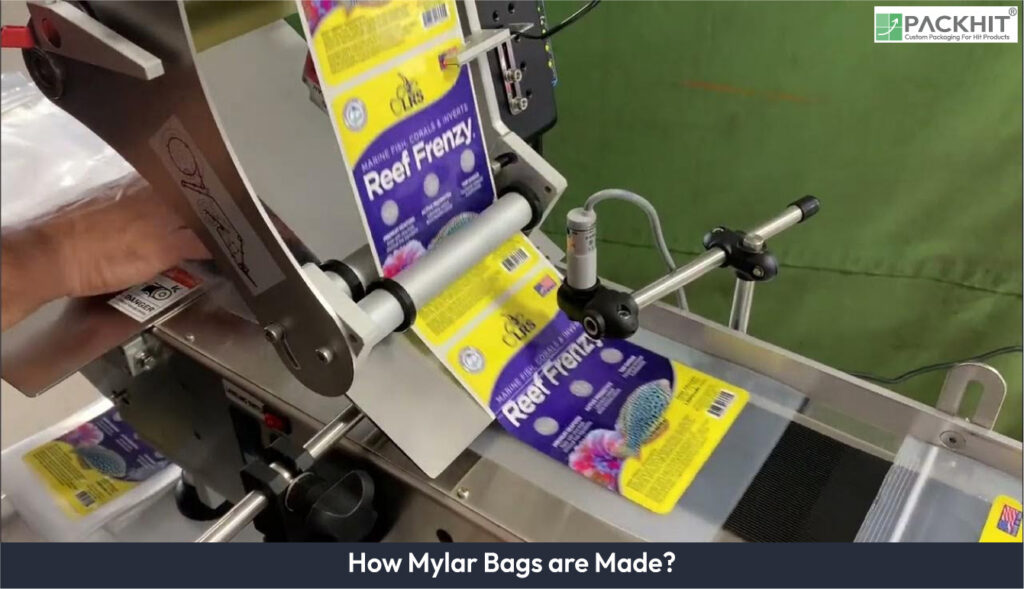The production of Mylar bags involves a detailed and precise process to ensure quality and functionality. First, polyethylene terephthalate (PET) resin is melted and extruded into a continuous film, which is then biaxially oriented to enhance its strength and stability. The film is coated or laminated with materials such as vapor-deposited aluminum or aluminum oxide for barrier properties, and optionally layered with polyethylene or nylon to improve flexibility and puncture resistance. Next, the film is slit into rolls of specific widths, then shaped into pouches or bags with heat-sealing technology, incorporating features like zippers or gussets as required. Finally, rigorous quality control tests verify the bags’ compliance with industry standards, ensuring suitability for applications such as food preservation, pharmaceutical packaging, and electronic component protection.
What is the Manufacturing Process for Mylar Bags?
The manufacturing process of Mylar bags is a meticulously engineered sequence that ensures the final product meets stringent quality and performance standards. Below is a detailed breakdown of the key stages involved:
1. Film Production
The manufacturing process starts with the extrusion of polyethylene terephthalate (PET) resin. PET pellets are melted and passed through a flat die, forming a continuous sheet of film. This film is rapidly cooled using chilled rollers, creating an amorphous structure. To improve mechanical and barrier properties, the film undergoes biaxial orientation, where it is stretched in both the machine and transverse directions under precise temperature controls. This alignment of polymer chains enhances tensile strength, clarity, and dimensional stability.
2. Coating or Lamination
The biaxially oriented PET film is coated or laminated with additional layers to meet specific functional requirements. Vapor-deposited aluminum or aluminum oxide (AlOx) coatings are applied to provide superior resistance against moisture, oxygen, and light. For enhanced flexibility and heat-seal properties, the PET film may be laminated with materials like low-density polyethylene (LDPE). Applications requiring puncture resistance often incorporate nylon layers. The choice of coating or laminate depends on the intended use, such as food preservation, pharmaceutical packaging, or electronic component protection.
3. Slitting
After the coating or lamination step, the film is slit into narrower rolls using high-precision slitting equipment. This process ensures the film is cut to the required width, facilitating efficient handling and preparation for the following stages. Proper slitting minimizes waste and ensures uniformity crucial for downstream processes.
4. Pouch Formation
The slit film is converted into pouches or bags using automated machinery. This stage involves cutting the film into specified dimensions, folding it into the required shape, and sealing the edges using heat-sealing technology. Additional features such as zippers, gussets, and tear notches may be integrated, depending on the design specifications and final application. For example, resealable zippers are common in food-grade Mylar bags, while gussets may be added for increased storage capacity.
5. Quality Control
Comprehensive quality control measures are implemented throughout the manufacturing process to ensure the final product meets industry standards. Inspections include visual checks for pinholes and coating uniformity, as well as advanced tests for gas permeability, tensile strength, and heat-seal integrity. Mylar bags intended for food or pharmaceutical applications undergo additional testing to comply with FDA food safety regulations and other relevant certifications. Continuous monitoring and adjustments ensure consistency and high performance of the end product.
Each step in the manufacturing process is carefully calibrated to deliver Mylar bags with the desired mechanical strength, barrier efficiency, and aesthetic appeal, making them suitable for a wide range of applications, including food storage, medical packaging, and electronic component protection.
What Materials are Used in Mylar Bag Manufacturing?
The primary material used in Mylar bag production is polyethylene terephthalate (PET), a thermoplastic polymer known for its strength, flexibility, and chemical resistance. PET is derived from the polymerization of ethylene glycol and terephthalic acid, resulting in a material with high tensile strength and excellent dimensional stability. In many cases, additional layers of materials such as aluminum foil, polyethylene (PE), or nylon are laminated to the PET film to enhance specific properties like barrier performance or heat-sealability.
Aluminum foil is often incorporated to provide an impermeable barrier against oxygen, moisture, and light, making it ideal for long-term storage applications. Polyethylene layers, typically low-density polyethylene (LDPE), are added to improve heat-sealing capabilities and flexibility. In some cases, nylon is used to increase puncture resistance, particularly for applications involving sharp or irregularly shaped contents.
How is the PET Film Produced for Mylar Bag Manufacturing?
The production of PET film begins with the extrusion process, where PET resin pellets are melted and forced through a flat die to form a continuous sheet of film. This film is then rapidly cooled on a chilled roller to solidify its structure. The resulting film is amorphous, meaning it lacks the crystalline structure required for optimal mechanical and barrier properties.
To enhance these properties, the film undergoes a process called biaxial orientation. In this step, the film is stretched in both the machine direction (MD) and transverse direction (TD) under controlled temperature conditions. Biaxial orientation aligns the polymer chains, increasing the film’s tensile strength, clarity, and resistance to tearing. The oriented film is then heat-set to lock in its improved properties and prevent shrinkage during subsequent processing.
What Coatings and Laminates are Applied on Mylar Bags?
To achieve the specific functional requirements of Mylar bags, the PET film is often coated or laminated with additional materials. Common coatings include vapor-deposited aluminum, which creates a reflective, light-blocking surface, and silicon oxide (SiOx) or aluminum oxide (AlOx) coatings, which enhance barrier properties while maintaining transparency.
Lamination involves bonding the PET film to other materials, such as aluminum foil or polyethylene, using adhesives or extrusion lamination techniques. The choice of laminate depends on the intended application. For example, food-grade Mylar bags often feature a multi-layer structure with PET, aluminum foil, and LDPE to ensure compliance with food safety regulations while providing superior barrier performance.

